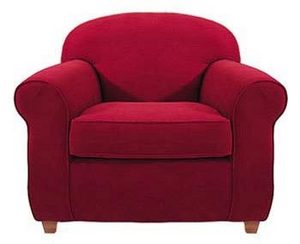Contemporary Interior Design Study Guide
Study Guide
Contemporary interiors have a mantra
: clean lines, sculptural furnishings, art, neutral elements and
bold color.
While some people dislike contemporary style
for looking stark and cold, others find it exciting, urban, and
fresh.
It's a look that often appeals to artists and architects
who love the underlying simplicity of line, shape, and form.
Notice how few accessories are needed
in the room pictured here. Both the accessories and art are
large scale, architectural, and add texture to this unmistakably
contemporary interior.
The color palette in a contemporary interior
can be anything from a mix of neutrals, to black and white, to
the use of bright and bold color. Black is often used to
ground and define a contemporary room.
Line may be the
single most important element of a contemporary interior. Look
for it in architectural shapes and curves, in the bold use of
black or color, in background details such as soaring ceilings
or tall windows, and in sculptural or geometric elements and
art.
If you love the look of contemporary, here are
some ideas for creating your own modern room.
Think of museum interiors
when planning a contemporary room: each element has its own
space, and is set off to stand alone while contributing to
the whole.
Architectural and functional elements
of a space are fully embraced in a contemporary interior,
whether they are beautiful or simply structural. Ceiling pipes
in loft spaces, broken brick walls in a former factory building,
metal ductwork, etc. is often left exposed, adding textural
interest and line.
Learn to see the negative space (the
areas around a particular object) and protect it.
Make bold statements with both
furniture and accessories. If you love red, put it up on an
accent wall or choose a bright red sofa or chair.
In both furnishings and accessories, skip the
small, pastel, and cute. Avoid ruffles, florals, carved details,
traditional shapes. Instead, go for the bold, artistic, and
sculptural.
Furniture generally exhibits clean, smooth
lines. Cover it in a neutral, black, or bold fabric. Fabrics
often have a natural look (wool, cotton, linen, silk, jute) and
add textural appeal.
Keep furniture details uncluttered.
Skirts are often either flat or box pleated, and have no
additional trimmings such as fringes or tassles. Legs are
exposed and in chunky, solid shapes. Pillows add shots of color
and texture in clean geometric shapes.
Flooring is generally smooth
and sleek in vinyl, wood, or low-pile commerical carpeting. Area
rugs can add more color, texture, interest, and space
definition.
Animal prints
are at home in many contemporary rooms. Try leopard pillows on a
black sofa or a zebra area rug.
Lighting is exceptionally important in a
contemporary interior. Look for unusual fixtures with
sculptural interest, clean lines, and perhaps accents of bold
color or metallic. Install recessed lighting or track
fixtures to wash walls with light. With new construction or
remodels look into installing indirect or cove lighting.
Highlight art by
placing sculptures on columns or pedestals. Install specialized
lighting for original art, framed prints, or posters. Use
repetition of line, color, and form.
In straight contemporary interiors it is most
effective to have a few large accessories well placed.
Give each piece breathing room by establishing a zone of empty
space around it.
Frame posters and prints simply
in classic black wood, colored metals, or light natural woods.
Hang groupings of pictures close together so they look like one
large piece of art.
Glass, metals, stone,
and wood will all fit well into a contemporary interior.
However, avoid a cold looking room by adding shots of warm
colors and providing textural interest in fabrics,
upholstery, rug, or accessories.
Think of each piece as sculpture.
Don't crowd it.
Flower arrangements
should be dramatic, large, and follow simple lines and shapes.
Place them in contemporary containers that add to the sculptural
look.
Plants will add
a shot of life to a contemporary room. Make them big,
place them in simple pots, and choose varieties that have
interesting leaves. Uplight them from the back and
underneath. Cover the dirt with smooth rocks or chunky bark
chips.
Dinnerware is
available in a variety of contemporary shapes, colors, and
styles. Keep it simple and add interest by combining a range
colors. Introduce texture with fabrics and placemats, metal,
twigs, and other "architectural" looking materials.
|
![]()
![]()
![]()
![]()
![]()
![]()
![]()
![]()
![]()
![]()
![]()
 Study Guide
Study Guide![]()
![]()
![]()

 The family of contemporary encompasses many
styles, among them Art Deco from the '20s, mid-century modern
from the '50s, Scandinavian from the '60s, Italian from the
'70s, and minimalism from the '90s. Whatever country they
might be from, contemporary idioms all hail from one decade
or other of the 20th century. The hallmarks of contemporary
furniture are:
The family of contemporary encompasses many
styles, among them Art Deco from the '20s, mid-century modern
from the '50s, Scandinavian from the '60s, Italian from the
'70s, and minimalism from the '90s. Whatever country they
might be from, contemporary idioms all hail from one decade
or other of the 20th century. The hallmarks of contemporary
furniture are: